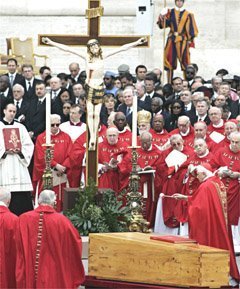Add new comment
Expert: Pope's body probably embalmed
ROME - Pope John Paul II's body was probably lightly embalmed before being exposed for public viewing for four days ahead of his funeral and burial, a Rome embalmer said Friday.
 |
Massimo Signoracci, whose family embalmed three previous popes but was not involved in John Paul's preparations, said some kind of treatment had to be done to allow the body to be displayed on an open platform inside St. Peter's Basilica.
"For a four-day viewing, injections of formaldehyde and other preserving liquids are necessary," Signoracci told The Associated Press, cautioning that he could not be certain what had been done without examining the body.
The Vatican has said John Paul's body was not embalmed, only "prepared" for viewing by hundreds of thousands of mourners, refusing to elaborate on the procedure used.
John Paul died Saturday, and his remains were put on public view two days later, through Thursday. His funeral on St. Peter's Square and burial beneath the basilica took place Friday.
Maria Campos Guereta, a 29-year-old banker from Jerez, Spain, was among the last mourners to file past the body Thursday. "Truth be told, he looked really haggard," she said.
Embalming aims at temporarily preserving bodies and creating an adequate time frame for visitations and funeral services.
As far back as the ancient Egyptians, people have used honey, wax, alcohol, oils, herbs and special body preparations. Today, modern techniques consist primarily of removing all blood and gases from the body and injecting a disinfecting fluid.
Signoracci said whether a body is lightly or deeply embalmed depends on the concentration of the preserving liquids. Embalming chemicals vary in their composition, but most are based on formaldehyde and methanol, or wood alcohol.
The process, which dramatically slows tissue decomposition, usually involves four parts: the injection of embalming chemicals into the blood vessels, body cavities and under the skin, and the suction of internal fluids.
Cosmetics, such as an oily foundation, are often used to create a more lifelike appearance.
Long-term preservation requires different techniques, such as using stronger preservative chemicals and multiple injection sites.
Embalming has been practiced in many cultures since ancient times. Ancient Egypt developed embalming to its greatest extent - mummification. The Incas of Peru also used a form of mummification. In Europe, embalming was sometimes used during the Crusades, when noblemen wished to have their bodies preserved for burial closer to home.
Signoracci said his family embalmed the remains of Pope John XXIII in 1963 and Paul VI and John Paul I, who both died in 1978.
Paul VI was only lightly embalmed before his body was placed on public display during a hot summer, and after two days, the skin and fingernails began losing color.
John XXIII's body was in excellent condition when it was exhumed from the cramped grotto under the basilica in 2001 - 38 years after his death - and moved to the main floor following his beatification.
Historically, organs were removed to make embalming more durable. Relics of 22 popes - from Sixtus V, who died in 1590, to Leo XIII, who died in 1903 - are kept in Rome's St. Anastasio and Vincent Church, near the Trevi fountain. Pope Pius X, who reigned from 1903-14, abolished the custom of removing organs.
UA-Reporter.com







